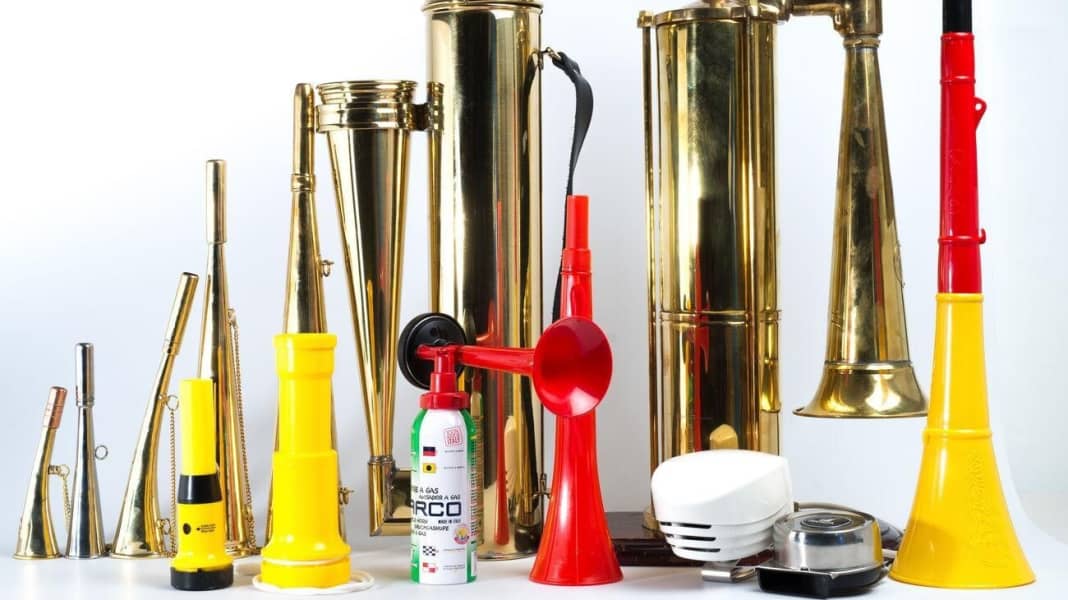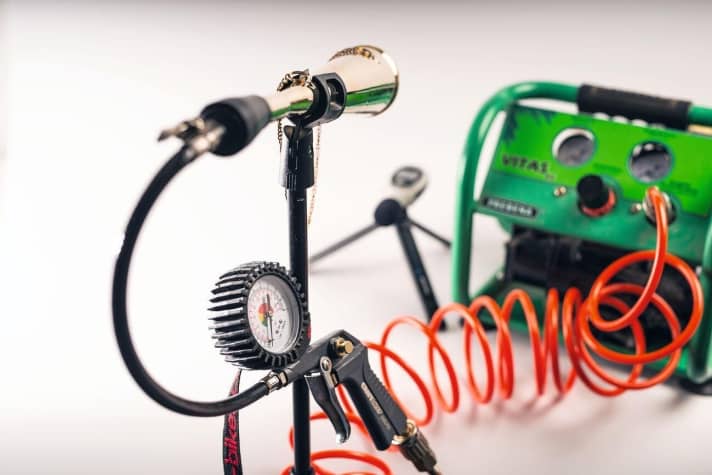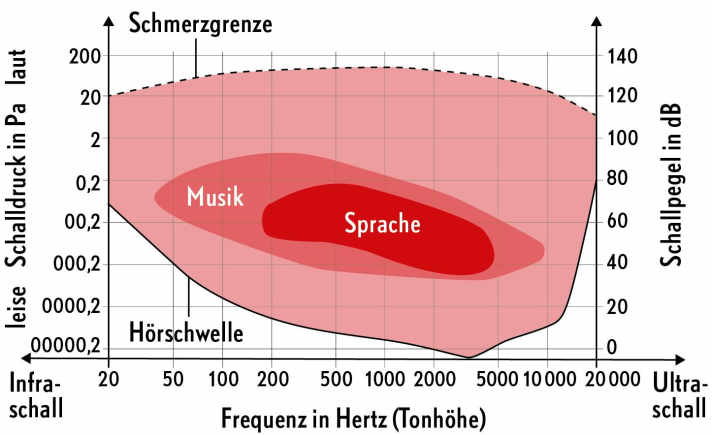
- This is what the foghorns sound like
- Test setup
- When are fog horns mandatory?
- How should I tint?
- High or low tones?
- The limits of physics
- The horn must be able to cope with 111 decibels
- Tradition means quality
- Plastic is fantastic
- Batten down the hatches Vuvuzela
- Pressurised gas brings sound pressure
- Just for comparison: E-horns
We analysed five classic metal foghorns, two hand-pumped models, three plastic models and a vuvuzela. We also compared one model with a gas cartridge and two electric models. The results are clear, the test winner surprising.
Matching:
But before we go into the details, here is the sound check:
This is what the foghorns sound like
Foghorn from Toplicht
Stainless steel foghorn
Sprenger foghorn 25 cm
Sprenger fog horn 35 cm
Top light siren
Toplight pump
Typhon's replica
Plastimo red
Trump big
Mini-Trump
Vuvuzela
Compressed air horn
Electric horn Marco
Electric horn Roca
Test setup

We had all mechanical horns from the test field of twelve products sounded on an adjustable compressed air tank for a test under constant conditions. As expected, there were no significant differences compared to the mouth-blown test. Two electric horns served as a reference. Two passes were measured in an open field with no wind. The sound pressure was considered individually for each device in the direction of sound, 90 degrees to it and in the opposite direction when tooting. We measured at a distance of 1, 5 and 75 metres using a standard digital measuring device. The frequency spectrum was determined using a smartphone app.
When are fog horns mandatory?
The fog at sea is opaque and frightening in both cases: Regardless of whether the soup is sea fog, i.e. moisture precipitating over cold water, or coastal fog, which occurs when the dew point is reached due to cooling land and covers the harbour entrance and direction finding objects. Suddenly, details are not even recognisable in the vicinity, and your own yacht is suddenly invisible to many others, so sound signals must be given. Even if, according to the Collision Prevention Regulations (KVR) in Appendix III, so-called "whistles" are only prescribed for boats over twelve metres in length, they are understandably also recommended for shorter yachts. The somewhat older term actually refers to fog horns.
How should I tint?
The length of a "long tone" is also defined in the KVR:
- Travelling through the water: A six-second acoustic signal must be given every two minutes
- Without travelling through the water: Two long tones two seconds apart
- Manoeuvring disabled: three long tones
This requires breath: normal breathing comprises around half a litre of air exchange, together with deep inhalation and exhalation, up to 3.5 litres of "vital capacity" are possible, decreasing to around 2 litres with age. This much in advance: With all mouth fog horns, normal breathing volume was sufficient for the required six-second sound signal.
High or low tones?
The best pitch for the maritime "Here I am!" is a compromise. This is because the diagram of human hearing resembles a bathtub, the "bottom" with the most sensitive values is between 2000 and 5000 Hertz. To the left and right of this, the hearing threshold, i.e. the quietest perceived sound, rises sharply. At 500 Hertz, a sound must already have an additional 10 decibels of sound pressure, at 100 Hertz over 20 decibels. This would speak in favour of high-pitched sounds rather than sound signals.

Physical conditions, on the other hand, suggest that the lowest possible frequencies should be used, as the range decreases rapidly as the pitch increases. For example, a 1000 Hertz tone at 20 degrees and 70 per cent humidity is attenuated about ten times more than a very low 125 Hertz tone of the same initial volume. A 4000 Hertz tone - where the greatest hearing capacity lies - is even attenuated 40 times more.
The limits of physics
The COLREGs therefore make sense: The fundamental tone of a fog horn for ships up to 20 metres must be between 180 and 2100 Hertz, for larger ships between 180 and 700 Hertz. The thicker the pot, the deeper - This is also common sense. For orientation: The telephone dialling tone sounds at 425 Hertz.
This specification deliberately accepts a further disadvantage. This is because the direction is difficult to determine below 800 Hertz; due to the speed of sound propagation, the time difference between the two ears of 623 microseconds is less than half the wavelength of the sound, so localisation is no longer possible. Sound transmission is also dependent on humidity.
However, only low humidity saturation affects the range, and only at high frequencies. In fog, i.e. 100 per cent humidity, low frequencies reach far. Windless conditions are also ideal - not only because there is no wind or waves as additional noise sources to isolate a fog signal from, but also because rough surfaces such as waves have an attenuating effect.
In any case, sound transmission is much more effective with the wind direction. This means that the "range" of 0.5 nautical miles specified in the KVR is a theoretical value. In practice, the personal hearing threshold, ambient noise, wind, humidity and temperature can result in very different ranges.
The horn must be able to cope with 111 decibels
The KVR also stipulate that the larger the pot, the louder the whistle. There is no specification below twelve metres, but between twelve and 20 metres it should be 111 to 120 decibels(A) at a distance of one metre, graduated according to pitch.
In this way, the poorer audibility of the low frequencies is given more weight than their greater range. However, it is not so easy to determine whether the "main pitch" of the horns is between 400 and 800 hertz or rather above 800 hertz. Their frequency spectrum is far removed from a "pure" tone. When in doubt, we made it a little easier for the horns and only allowed 111 decibels as the limit everywhere. Only two products reached this sound pressure level: the classic Martinshorn and the Trump from Plastimo.
Incidentally, ships over 20 metres must roar at 130 decibels, over 75 metres 138 decibels are required and over 200 metres the horn must boom at a minimum of 143 decibels. The values apply in advance; from 45 degrees deviation from the funnel direction, 10 decibels less are permitted. We have also taken this into account. The two sufficiently loud horns in the main direction also passed this hurdle. We did not measure a reduction of up to 15 decibels for any of the participants. However, all but two were quieter than required by the standard. Whereby quieter in this case does not mean quiet: we measured 95(A) decibels on a car horn, while even the Nirohorn, which was only 19 centimetres long, reached 94 decibels. With a significantly higher pitch and less power, the two small horns, which we obtained from Toplicht and Watski/Gotthardt, scored better in terms of the jam volume; they are also solid and of high quality. The same applies to the ten centimetre longer curved Sprenger horn. The much bulkier 35-centimetre horn from the same manufacturer reached an impressive 106 decibels. But the conventional horns can do even better.
Tradition means quality
The history of Deutsche Signal-Instrumentenfabrik Max B. Martin, which today manufactures in Philippsburg, dates back to 1880 - including the Martin horn in all its variants, usually referred to as the Martinshorn. Supplier Toplicht summarises: "You can't get more traditional than this." The quality pays off, the largest and heaviest brass mouth horn is the loudest of the classic models, but it also costs an impressive 75 euros. Its production in Germany and the individually available replacement reeds, each carefully tuned to F sharp, are charming. Unfortunately, one reed alone costs as much as other complete foghorns.
At first glance, the two pumping foghorns appear to be very practical, as persistent blowing is a strenuous activity - but so is persistent pumping. The lighter of the two pumping horns only makes a sound in the direction of impact. The larger one sends the air flow through the horn both when pushing and pulling, but at 6.3 kilograms it is only suitable for use on board small yachts to a very limited extent. In addition, persistent pumping is a pain in the arse. According to the sender, it is mainly ordered for decorative purposes. The deep tone of the large product sounds effective at close range, but we measured average values in the 75 metre test.
Plastic is fantastic
The red horn from France's largest manufacturer Plastimo is very robust, but its plastic reed only responds to a much stronger airflow than its metal counterparts. The robust part is almost the recommendation from this test, were it not for other variants that are also made of plastic and are even more effective. The impressive sound pressure level is generated by blowing air in from the side.
The small Mini-Trump can even be transported on the surfboard in the breast pocket of the lifejacket and can be retracted to almost half its size. At the beginning, our eyes almost popped out of our heads when we inflated it. This was remedied by carefully pulling the outer body and membrane part apart, a tenth of a millimetre was enough. Nevertheless, the only slightly more expensive and larger Trump is the clear recommendation; it is the loudest in the test.
Very nice: despite the favourable price, the horn comes with two replacement membranes and a storage box. It's best to put two earplugs in the box, as the Trump is the loudest on the ear due to the side outlet. We measured 128 decibels, which is the pain threshold for the horn. In any case, ears should be pricked up during breaks for possible sound signals from other ships. It is therefore advisable to wear hearing protection when using all test candidates.
Batten down the hatches Vuvuzela
Since 2010, the football fan instruments originating from South Africa have also been well-known in Europe, and in some cases notorious. Many criticised their high volume at the time and they are now banned at Uefa matches. We analysed the noisemaker and measured a powerful 102 decibels. The sound pressure next to and behind it is also astonishing, although the slim shape seems to indicate a "main sound direction". The fan instrument isn't bad at all, but it doesn't have a reed; it has to be blown like a trumpet, which leads to furry lips in the long run if there isn't an experienced brass player in the crew on standby.
The vuvuzela is made of three parts so that it falls apart when used as a percussion instrument. This is only of interest to very choleric skippers or annoying crew members, but with this function the horn is also easy to dust.
Pressurised gas brings sound pressure
The pressurised gas fanfare is one of the loudest in the test. We measured a total of around four minutes of continuous sound per cartridge, i.e. theoretically around 40 "long tones". In practice, however, this is hardly possible, as the pressurised cylinder becomes so cold when the sound signal is prolonged that it has to be held with gloves. The cooling also has an effect on the air flow, and the sound fades to complete silence after just a few seconds if it is pressed several times. Even pressing over the head only helps for a short time. After intensive use, only the shortest horn blasts are possible. The funnel and attachment are barely connected and fell apart.
The fanfare is therefore ideally suited as a loud warning device, but a second signal should be included as a backup. The 200 millilitre cartridges are pressurised to 18 bar. Tetrafluoroethane (CH2-F-CF3), a commonly used refrigerant in cooling systems, does not destroy the ozone layer like the harmful fluorocarbons, but is still one of the greenhouse gases that contribute significantly to global warming.
Just for comparison: E-horns
The two electric candidates initially scored full marks, especially in the secondary directions, but at 75 metres we only measured 60 decibels or less. This is, of course, offset by the ease of operation and the fact that they are usually optimally positioned on the spreader far above the water. This is not only better for the range, but the horns are also further away from the crew's ears. As the on-board power can fail, especially in emergency situations, a second fog horn from our test is recommended for electric horns.

